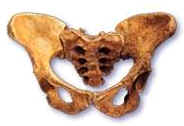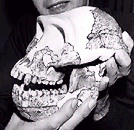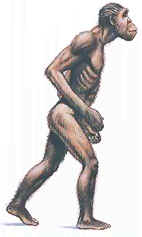
Lucy

These are the fossilised remains of Lucy, a girl of around 12, who lived approximately 3.2 million years ago. Her fossils tells us a lot about early humans.
Lucy is the most complete (40%) skeleton of Australopithecus afarensis ever found. She was discovered in 1974 in Hadar, Ethiopia, and was named Lucy after the Beatles song 'Lucy in the Sky with Diamonds', that the archaeologists, Don Johanson and Tom Gray were playing at the time of the discovery.

You can tell that Lucy is a girl because females have a wider pelvis, with a larger gap which allows a baby's head to pass through. We can tell that she is around 12 because of her size and bone development.

Her pelvis also tells us that Lucy walked upright on two legs, as it looks much like a modern woman's. The broad, flat bones on either side, called the lilac blades, curve to form a pelvic basin, which helped to support her internal organs and upper body as she moved.

Fossils are formed in sedimentary rocks. When this girl died, her skeleton was covered with layers of sand and silt in conditions that protected the bones from decaying. The soft tissues, organs and muscles have decayed, but the bones have undergone a chemical reaction that turns them into rock. The sediments will bury the fossils deeper in time. We can estimate the age of the skeleton by comparing this layer of rock with other strata, but for more accurate measurement we can use potassium or argon dating.

From Lucy's face we can see that she has a sloping face, protruding jaw and prominent eyebrow ridges; she was obviously not a modern human. We can reconstruct soft tissues (in the same way and forensic artists do with a murder victim). If you know the muscle structure and the average skull depth of the soft tissues at strategic points on the skull, you can use clay to reconstruct the face.

Lucy has dangling, powerful forearms, which would have made her a good climber, and she may have spent some time in the trees. Her upper arm bones are long and sturdy compared to those in modern humans.
